Riviera Yucatán
Along the Riviera you will be able to appreciate the great variety of ecosystems such as tropical forests, cenotes and underwater caves that come together to make this an unforgettable experience.
Along the Riviera you will be able to appreciate the great variety of ecosystems such as tropical forests, cenotes and underwater caves that come together to make this an unforgettable experience.
Talking about the Yucatán Riviera is talking about the richness and variety it has. It has an extension of approximately 378 km from the beaches of Celestún all the way to El Cuyo. Along the Riviera you will be able to appreciate the great variety of ecosystems such as tropical forests, cenotes and underwater caves that come together to make this an unforgettable experience.
This region includes the 11 municipalities of: Celestún, Dzemul, Dzidzantún, Dzilan de Bravo, Hunucmá, Ixil, Progreso, Sinanché, Telchac Puerto, Ucú and Yobaín, of which only Celestún, Hunucmá and Progreso are the most important seaports.
It has a unique gastronomy with ancestral recipes which is blended with the particular flavor of the seafood of the area to create a range of options to delight yourself.
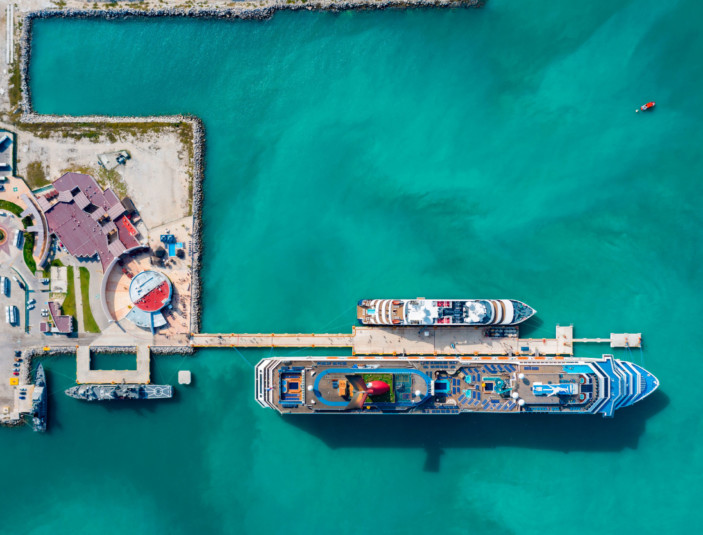 Puerto Progreso
Puerto ProgresoIt is located 30 km from Merida. It is the first deep-sea port and the most important of the Yucatán coast. It has all the natural elements for practicing different activities and has been adapted as a tourist center.
Its beaches have white sand, are rather shallow and the waves are calm with no currents. This makes it an ideal place to practice various water sports such as windsurfing, kayaking, sailing, swimming, paddle boarding and many others.
The waterfront has restaurants with Yucatecan and seafood specialties, typical handicraft stores, live music and a panoramic view of the beautiful beach. In addition, its waters are rich in marine species, so fishing is also an option.
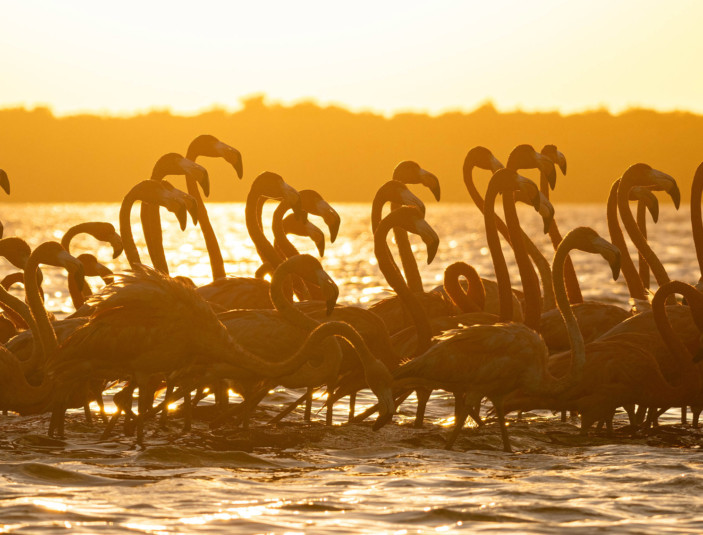 Celestún
CelestúnNatural eco-touristic paradise with an exceptional landscape and extensive beaches full of coconut trees and mangroves that are part of the world heritage of the Celestún Biosphere Reserve. Approximately 400 species of migratory birds have been identified in the area, and it is one of the two sites where the pink flamingo nests, feeds and reproduces. It has an area of 59,139 hectares and a length of 21km, officially declared a wildlife refuge since 1979.
Celestún has freshwater wellsprings hidden in the natural tunnels formed by the branches of the mangrove, where you can swim. The Baldiosera spring is the largest concentration of freshwater inside the mangrove and has small docks for visitors to access the site.
It also has the extraordinary petrified forest named Tampetén and Punta Ninúm, where clams and miniature shrimp abound. Here you can also observe 234 different species of mammals that live in the estuary, amongst the main ones are the ocelot, jaguar, margay and spider monkey, which are considered endangered species along with three species of sea turtles and two species of crocodiles.
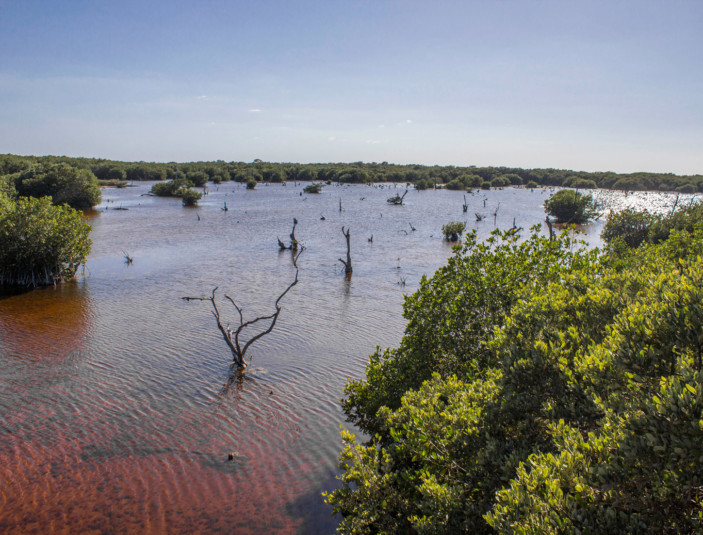 Rivereños el Tigre, Hunucmá
Rivereños el Tigre, HunucmáHunucmá is located just 40 minutes from Mérida. It is a place worth visiting if you are looking to get to know the current Mayan culture. A picturesque city that welcomes you with architectural and natural surprises that will give you a quiet and memorable traveling experience.
It has access to Sisal that is one of the most beautiful ports on the coast of Yucatán where you can practice ecotourism and archaeo-astronomy.
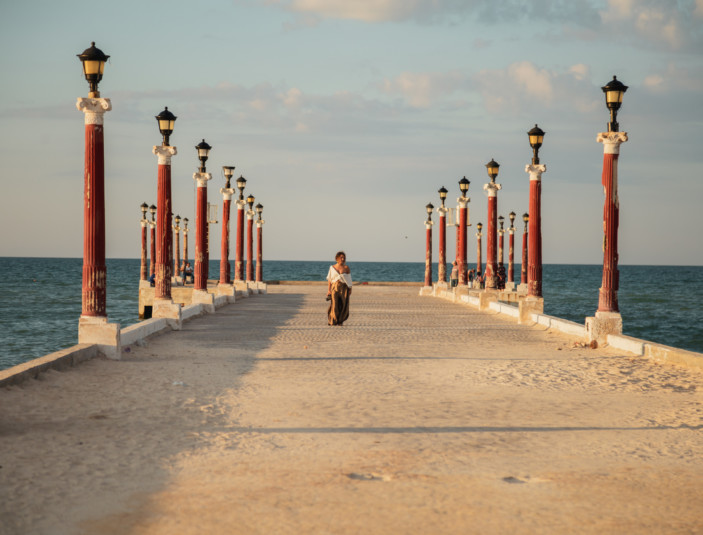 Sisal Pier
Sisal PierSisal has been a fishing port by tradition which is the main activity of its population. It is located in the municipality of Hunucmá. The freshness of its seafood gives an excellent flavor to all the dishes that are prepared in its restaurants and that tourists delight in. During the colony it was the port of arrival of merchandise for the rest of the state, for that reason the fort and the lighthouse were built, which are nowadays some of its main attractions.
The guided tours by kayak through the natural reserves are the best option for lovers of nature and ecotourism. Birdwatching and walking through the mangroves are activities you will enjoy to the fullest. In Sisal you will find a peaceful and quiet place to bond with nature and reconnect with your family.
For those who prefer to observe nature, in the waterfronts and docks of the main ports, you can hire a boat tour to experience the adventure through the mangrove area, admire the beauty of the birds, vegetation and fauna.
A unique experience in which the tour guides lecture about the great variety of birds and animals that you can see during the journey.
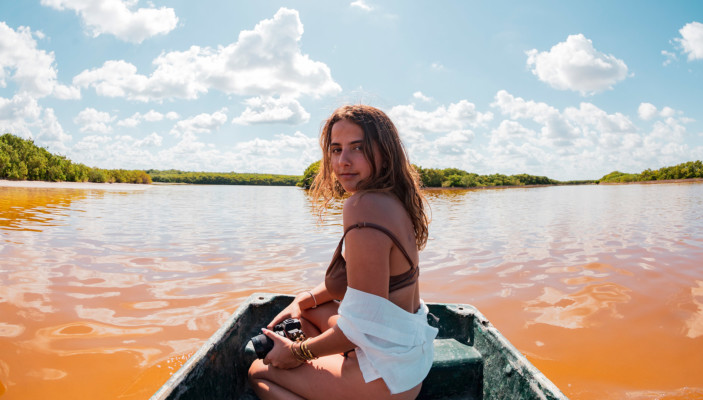 Boat trips
Boat tripsThe practice of kayaking, as a recreation, provides an exciting sense of adventure since it allows you to admire beautiful sites, which would not be accessible in any other way. It is an excellent option to visit estuaries, lagoons, mangrove tunnels and enjoy the tranquility of the sea.
Go for it! Enjoy this adventure in the company of friends or family. And, don’t forget that you can hire the transportation from Mérida with the cost of the tour included.
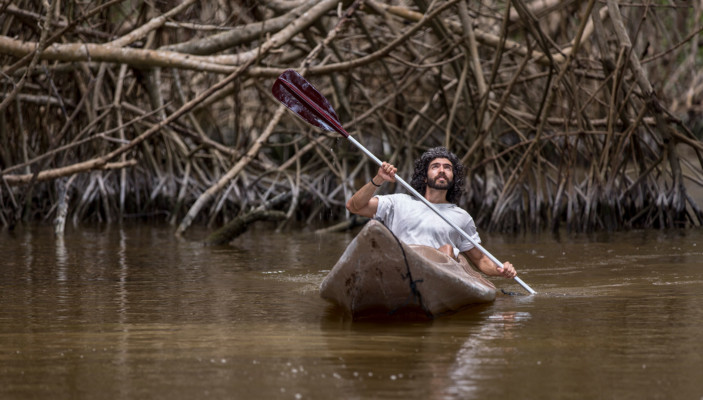 Kayak
KayakKitesurfing is an extreme sport that consists of sliding on the water in which the wind propels a traction kite attached to your body through a harness, so you can ride a surfboard over the waves or perform maneuvers in the air.
Chuburná and the Yucalpetén beach, famous for having shallow waters and strong winds, are ideal to learn this extreme sport that will awake your adventurous spirit.
In the International Rowing and Canoeing Trail in Progreso, experts can test their skills in deep and fast rapids; beginners can also have the opportunity to take free lessons to live the experience.
If it is your first time practicing this sport, dare to take your first individual and personalized class. So you can sail over the waves, feel the wind and the adrenaline flowing all over your body. Don't forget to hire a certified guide who can lend you the equipment and give you the proper guidance, since handling a board in any of these sports takes several hours of training.
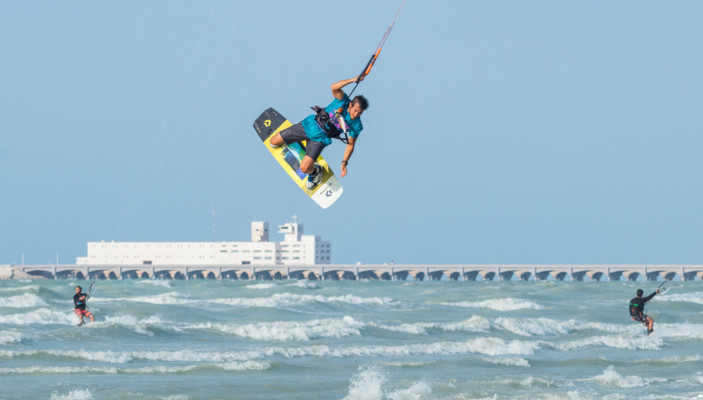 Kitesurf
KitesurfWalking along the seafront (referred as “malecón”), allows you to enjoy the sea breeze and to savor the delicious regional food in any of the restaurants that surround it. At the end of the tour we suggest you take your souvenir photo at "La casa del pastel", located right at the end of it. This is an eclectic building that shows Art Deco ornamental elements.
There is a great variety of restaurants suitable for all budgets and tastes, from places where you can try eccentric seafood dishes to the simplest ones like stalls that sell traditional fried fish.
You can also find all kinds of shops and retail stores right on the main street of the seafront, where you can buy some drinks and nibbles during your stay.
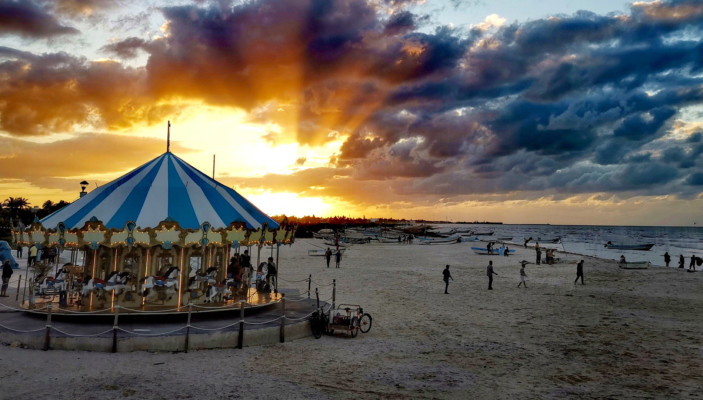 Carousel of the international boardwalk of progress
Carousel of the international boardwalk of progressThe Alacranes Reef National Park is a Natural Protected Area of great importance in our country. Mainly because it covers the largest coral structure in the Gulf of Mexico, and also for being the only reef complex in the State of Yucatán. It is formed by five islets: Isla Pérez, Isla Blanca o Chica, Isla Muertos o Desertora, Isla Pájaros, and Isla Desterrada. The reef is surrounded by shallow tropical waters. The vegetation of the islands is made up of dune and mangrove species.
The main starting point to access the Park is Puerto Progreso. The entrance to this area must be done by watercraft (boat, dinghy, etc). Some of the activities that can practiced are recreational diving, flora and fauna observation, boat trips, recreational fishing and boat rides.
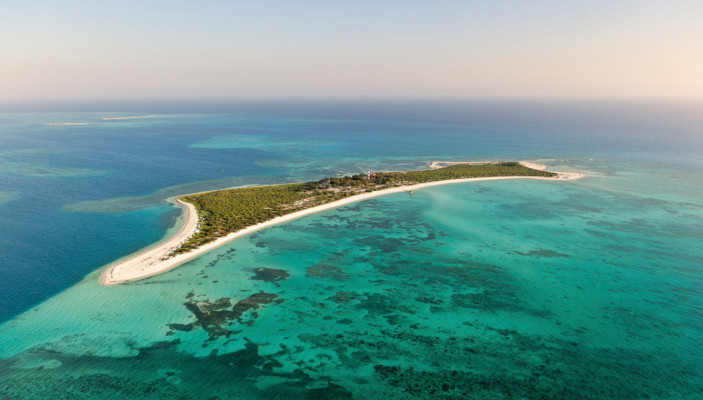 Alacranes Reef
Alacranes ReefElevated wooden trails, a majestic canoe trip (through channels and mangrove tunnels) or by bicycle, camping and cabins to lodge in are some of the attractions that this place offers. Its facilities use environmentally friendly technologies, such as solar energy.
In order to make this trip, it is necessary to arrive at the tourist inn located next to a soccer field on the Sinanché-Xitibcanul road. The tour through the mangrove is in a small boat with a maximum capacity of 4 people plus the guide who pushes the boat with a rustic oar.
There is no need to worry if you don't know how to swim, the depth of the section where the small boat goes through is about 30 to 40 cm deep. During the half-hour trip to the wellspring you will be able to see a great variety of wild species such as birds, snakes, turtles and even lizards.
 Mangroves
MangrovesLocated between Telchac and Dzemul, a group of fishermen decided to rescue the salt work and revive the beautiful lakes of Xtampú, thus creating the Meyah Ta'ab cooperative.
Unlike "Las Coloradas", these salt flats are much closer to Mérida and getting here is very simple, as you only have to take the road to Progreso, pass Telchac beach and head to Dzemul.
The peculiar pink color is due to the high concentration of salt and the crustacean "Artemia salina" which also serves as food for the flamingos that surround the area.
 Xtampú Salt Lakes
Xtampú Salt LakesEl Corchito is ideal for those keen of nature and prefer quiet places. It is considered one of the most important ecological reserves of the Yucatán coast. It is located in the swamp; therefore, it is possible to observe a wide variety of plants and birds. You can also swim in the wellspring in the lower parts of the estuary.
It is located in an area of watery cenotes perfect for the observation of flora and fauna, surrounded by varied vegetation, which serves as a refuge and source of food for various species such as birds, crustaceans, mollusks and reptiles among others. In this paradisiacal place there are cenotes and wellsprings that you really should visit.
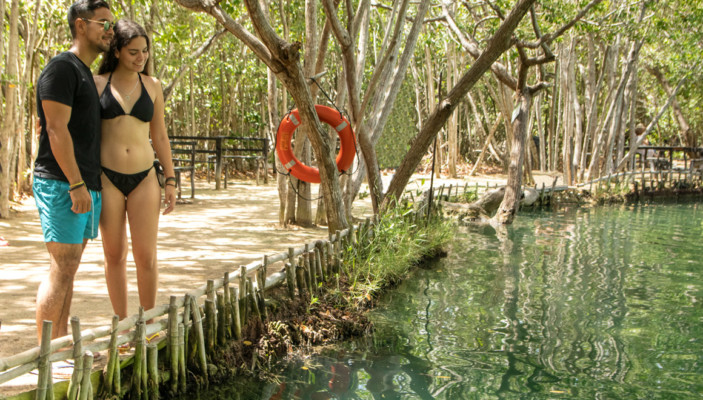 El Corchito
El CorchitoAs you enter, you will find the first cenote very close to two wellsprings. Afterwards, you will come to the "Cenote Venado" which is on the left side. This one is wide, clean and a bit deeper, to reach it you have to pass by the bridge that gives you a magnificent view of the place.
The cooperative of the place offers some facilities such as palapas for resting, a camping area, and a bridge to cross the channel and the dock. It also has tourist services that include tours of the springs every day of the week, starting at the dock.
El Palmar is also a protected area where migratory water birds live, such as the Canadian duck, which hibernate and reproduce in the area. It is considered one of the most important ecological reserves in the state because of its abundant flora and varied fauna, ideal for ecotourism lovers. It is located 80 km from Mérida.
The Mayan Port region, located in the northeast of the state, is made up of the municipalities of Panabá, Río Lagartos, San Felipe, Sucilá and Tizimín.
The coast of this region offers a unique natural spectacle, with protected natural spaces and a diverse fauna. The star of the colonial part is in the hands of Tizimín, in addition to being one of the main cattle raising municipalities of the state.
From the deep blue color of the cenotes of crystalline waters to the pink explosion of the flamingos. Walk along the shores and admire the incredible exuberance that covers the Mayan coast of Yucatán. Travel the coast by boat and be a privileged spectator of the immense flocks of flamingos that cloud the sky as they fly by. Sail through the quiet mangrove and set your imagination free.
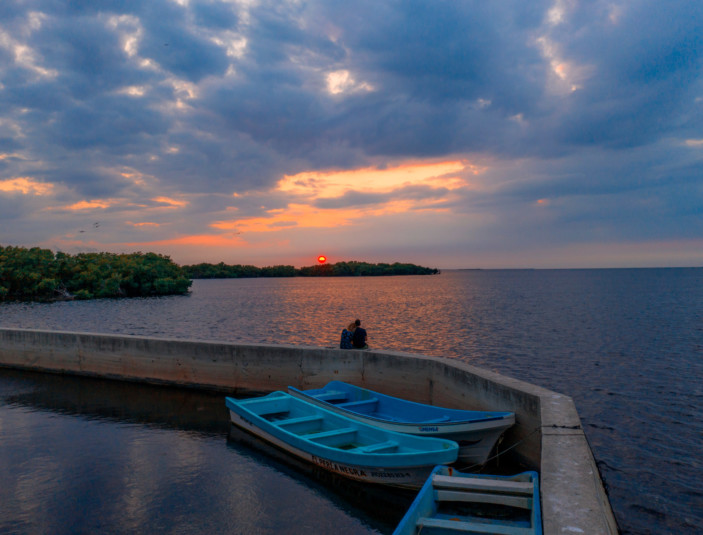 San Felipe
San FelipeSan Felipe is ideal to forget about the hectic life of the city and experience total relaxation. Its homes are still made of wood and are decorated with very vivid colors and tones. A sight to behold as you walk through its streets.
Today, it has become one of the most important tourist spots in Yucatán, due to the unique beauty of its surroundings, especially for those who love being immersed within nature.
In addition to the tours around the nearby mangroves, sport fishing is one of the main attractions of the area. Generally, the local residents are in charge of organizing it, as they know the best fish concentration locations. The friendliness of the inhabitants of the port will embrace you, given that they are the main ambassadors of the ports and promoters of their tourist attractions.
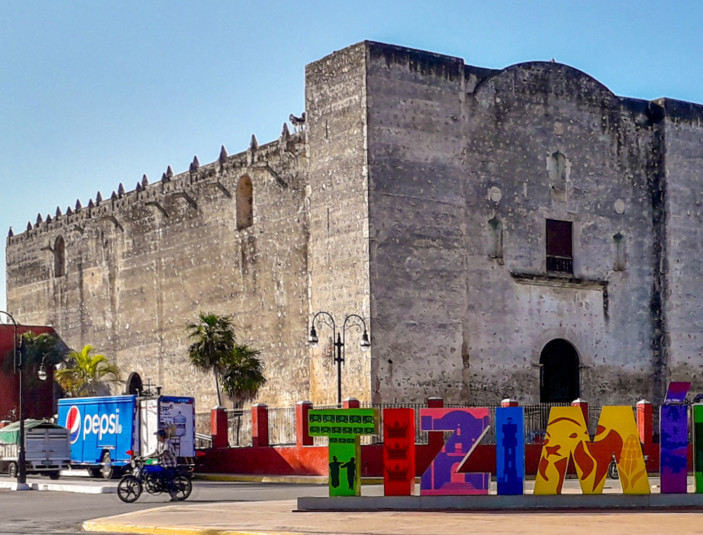 Tizimín
TizimínAlso named as "Place of the Tapir", only 2 hours away from Mérida. Tizimín is known as the City of Kings, for its renowned traditional festival in honor of the Three Kings, a tradition that began during the colony and is has been preserved until now. For more than a week, the largest livestock and commercial festival in the northeast of the state is celebrated. Important religious ceremonies take place during these days.
Some of its main attractions are:
Historical Center
Downtown, people can enjoy strolling around a beautiful and quiet square, and visiting the Cathedral of the Three Kings. The church has a particular architecture as it does not have high towers or bell towers like others in the state.
Municipal Market
Its round shape, provides a different and unique view. The sale of products becomes a festival of colors and flavors. There are stalls that sell meats in its center, and fruits and vegetables stores are distributed around them.
During the first days of January a festival is held in honor of the Three Kings, as well as an important procession and a traditional fair.
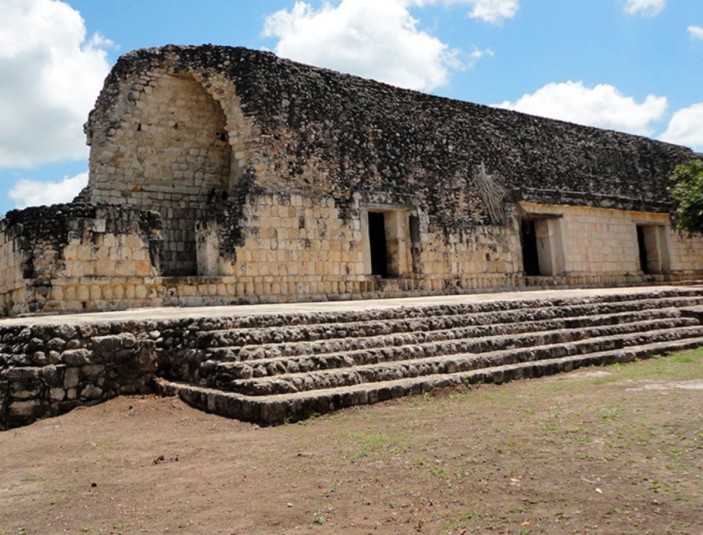 Ruinas de Kulubá
Ruinas de KulubáAs a matter of fact, these places are "sascaberas". In other words, tunnels and chambers from which the "sascab" material used in construction was extracted. Nowadays, inside them you can see engravings, paintings and images of the three kings which are visited by thousands of tourists.
A recently opened site for tourists, lost among the old ranches, its buildings emerge mystically from the ground among nature. The Temple of the Masks and the Palace of the Chenes are the most relevant.
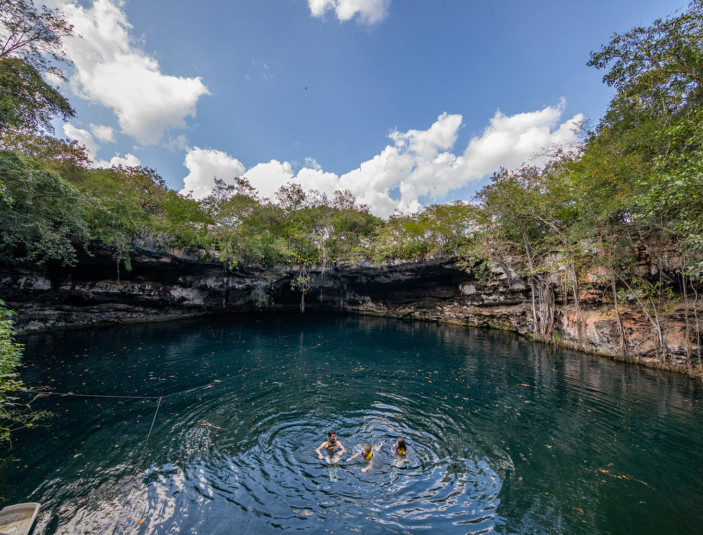 Cenote Kikil
Cenote KikilThe beautiful cenote is colossal! It is estimated that it has 55 meters of depth and 30 meters of diameter, that is why it is imperative to extreme precautions. The place is managed by the community's cooperative and by visiting it you will be contributing to its economy.
The tourist center has varied amenities, which makes it an ideal place to spend the day with family and friends.
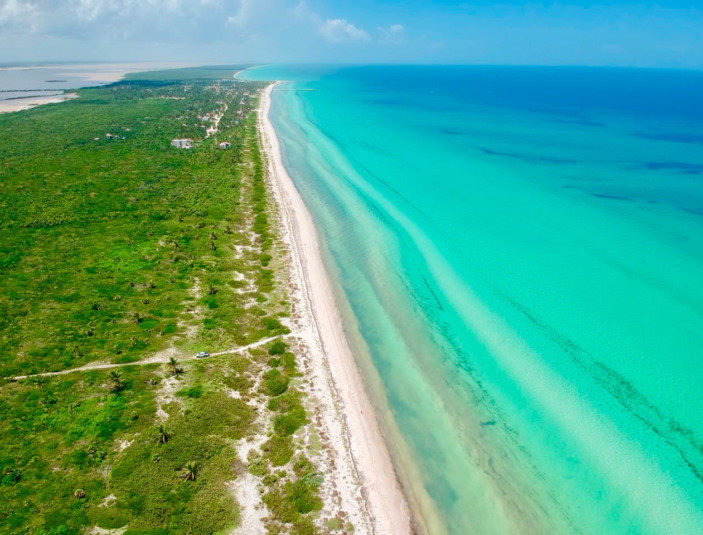 El Cuyo
El CuyoThe Cuyo is the small port of the municipality of Tizimín within the Ría Lagartos Biosphere Reserve. It is located on the boundaries with the state of Quintana Roo. It is a great place to practice ecotourism or adventure.
You can spend a pleasant vacation relaxing in one of the villas that are rented for this purpose. If you prefer, it can also be a starting point for visiting the Ría Lagartos Natural Park.
Only 12 kilometers separate the port of San Felipe from Río Lagartos, from where you can take a tour that will give you a memorable experience and let you be contact with nature.
The recommendation is to book ahead of time a tour with the specialized agencies in the area. They know the best schedule for bird watching, including the beautiful pink flamingoes. More than 80 kilometers of the river cross through three of the region's municipalities: San Felipe, Río Lagartos and a part of Tizimín. It was declared a Biosphere Reserve in 1979, in order to preserve the ecosystem, along with more than 250 species that live there.
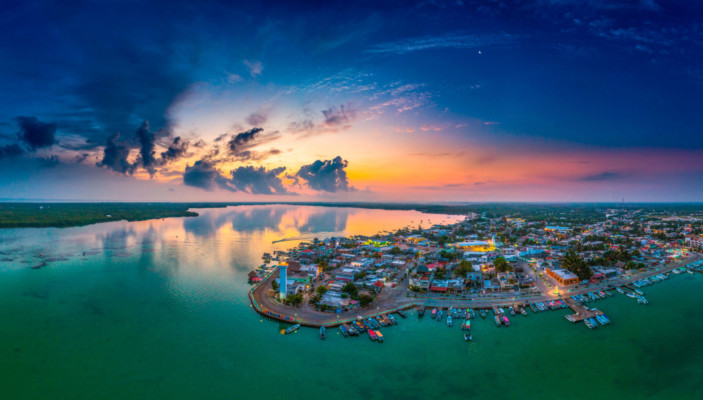 Río Lagartos
Río LagartosThe tour lasts about 4 hours. During the tour you will be amazed by the natural wonder of the Yucatán coast and its fauna. The main attraction of the tour is undoubtedly the pink flamingo. However, pelicans, white herons, cormorants, storks and some crocodiles are very common to see throughout the tour.
There is a spot where you will get to the Mayan Bath. In this place you will be able to immerse yourself in water with a high concentration of salt and sulphur, so the bath will be very soothing. When you leave, you will "exfoliate" your body with a kind of clay that will cover you completely. After a few minutes, once it dries and its properties have had the desired effect, you will arrive at a beach where you will wash off all the clay and feel the softness of your skin. The return to the starting point will mark the end of the tour.
Las Coloradas are located within a private area, property of the Salinera de Yucatán. Access is permitted, but you must bear in mind that they are not suitable waters for swimming, firstly because we would affect the production of salt by contaminating the water and secondly, because of the high concentration of minerals and the temperature of the water.
Its unexplored beaches make them an excellent place to enjoy the sun and to spend time with your couple, family or friends. The road to Las Coloradas is also an excellent opportunity to admire the landscape and the sand dunes.
Finally, you will be able to groove on the beauty of the flamingos that linger in this place. These birds can be seen in greater detail in the pink waters of the salt flats.
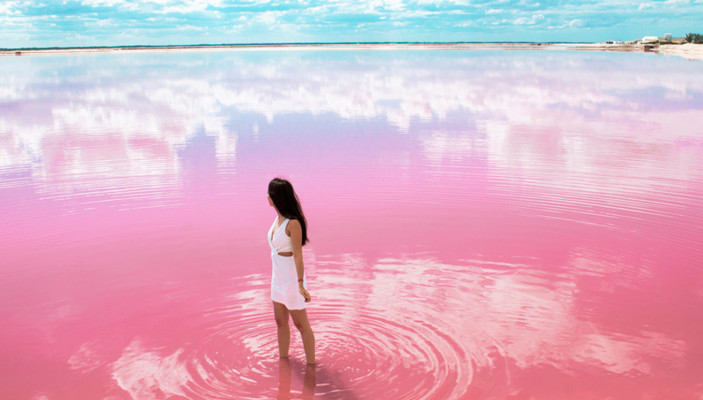 Las Coloradas
Las ColoradasOn the way to The Coloradas you will find different cities that were founded by the Spaniards, such as ruins of former convents and big haciendas. This way you will not only have a great time at the beach, but you will also get to know a little bit of history. Also, in the hidden houses you will see different cenotes that have crystalline waters.
You can get there from Mérida. However, if you already are in Río Lagartos, it would be much closer, only 20 minutes away.
The region of the Capital of the Mayan World is one of the most representative of the state, given that the municipalities that comprise it are important historical centers, cultural centers and important archaeological sites such as the new wonder of the modern world: the Pyramid of Kukulkán in Chichén Itzá.
The modern Mayans still live within the boundaries of their ancient empire in Central America. In spite of the dominion of the European for half a millennium in this country, much of the native and historical Mayan tradition has been upheld among its people. The secret of the Mayans to keep their native culture alive seems to be their adaptability. Even though the culture could not avoid being influenced by modernity, it managed to preserve many of its traditional bases.
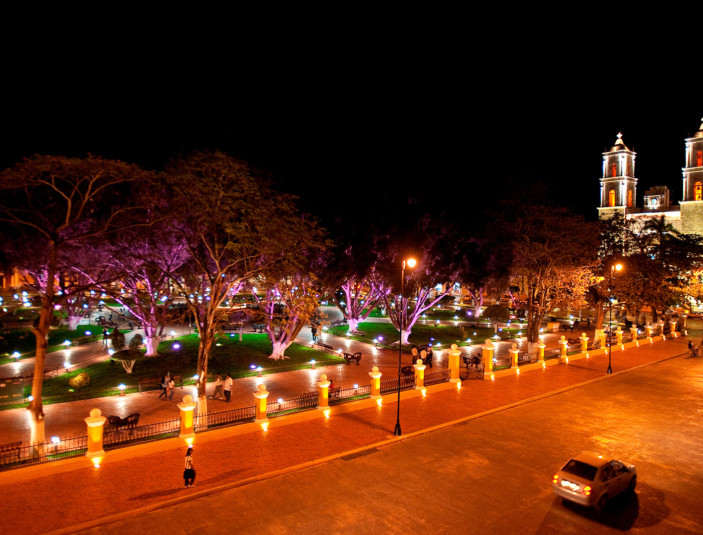 Valladolid
ValladolidNowadays, known as "The Capital of the Mayan Orient", Valladolid is one of the two Magical Towns of Yucatán. It is a beautiful destination, since it has kept the architectural beauty of its ancestral colonial buildings. It also provides a quiet place to enjoy your vacation, where you can mingle with a deep-rooted culture, history, legends, handicrafts, the nature of its cenotes, archaeological sites to admire and learn more about the Mayan culture. Not belittling its exquisite food with mestizo recipes, it is highly recommended to try the famous sausage of Valladolid.
Valladolid is located right in the middle of the two most important cities of the Yucatán Peninsula, Mérida and Cancún, both approximately 160 kilometers away. In addition, the main archaeological wonders of the area are fairly near: Chichén Itzá is only 45 kilometers away, and Ek Balam just 30 kilometers away.
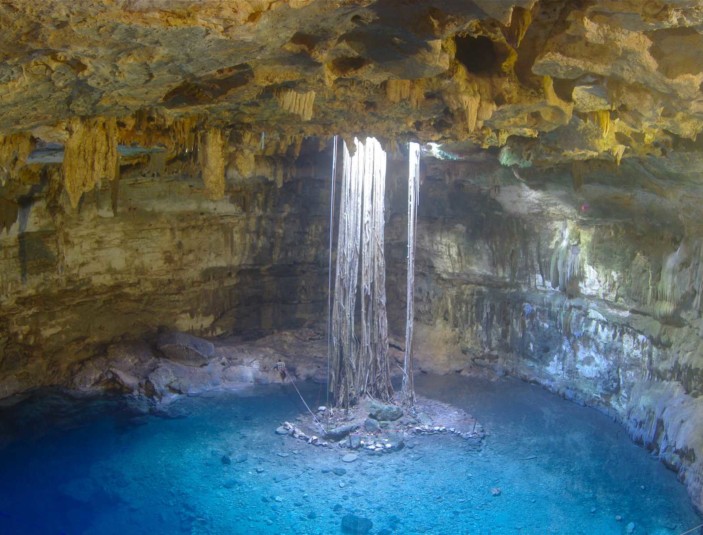 Cenote Dzitnup
Cenote DzitnupCenote Dzipnup is a closed-type cenote inside a grotto, its entrance is a narrow tunnel through which you descend by a staircase carved in rock to the interior of the cenote. The sunlight that enters through an opening at the top of the vault gives the water a turquoise blue hue which illuminates the water mirror that measures 30 meters long by 20 meters wide, with a minimum depth of one meter and a maximum of 20 meters.
It is managed by the Board of the Cultural and Tourist Services Units of the State of Yucatán (Cultur), which monitors and maintains the quality of tourist services through the collection of an admission fee. It is an ideal place for swimming due to its shallow depth. It is recommended both to wear life jackets and to avoid using sunscreen and insect repellents. It is strictly forbidden to throw garbage into the water.
This cenote is inside an underground chamber located 7 km southwest of Valladolid. You can see formations of stalactites and bright turquoise waters illuminated by natural light that penetrates through a hole in the central part of the vault. The water is shallow and so crystal clear that you can see a variety of fish swimming around.
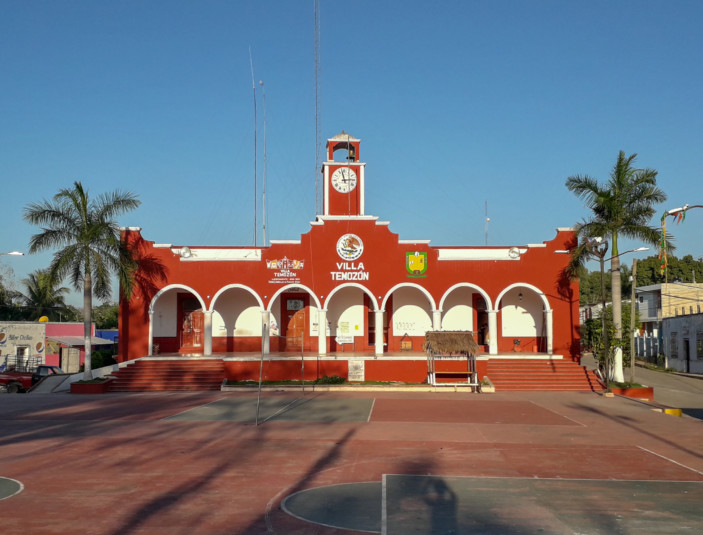 Temozón
TemozónTemozón ("swirlpool site") is a peaceful community widely known for the smoked meats offered in more than 18 butcher shops along the main street, as well as for the fine cedar furniture you can find in more than 60 carpentry and furniture shops. Most of these businesses are family-owned and have been operating for several decades, preserving and perfecting the ingredients and meat products together with the techniques and designs in wood.
Temozón is located very close to Valladolid, just 8 minutes away towards Tizimín. The community of Temozón offers tourists a different experience that alluringly blends gastronomy, history, natural beauty and archaeology.
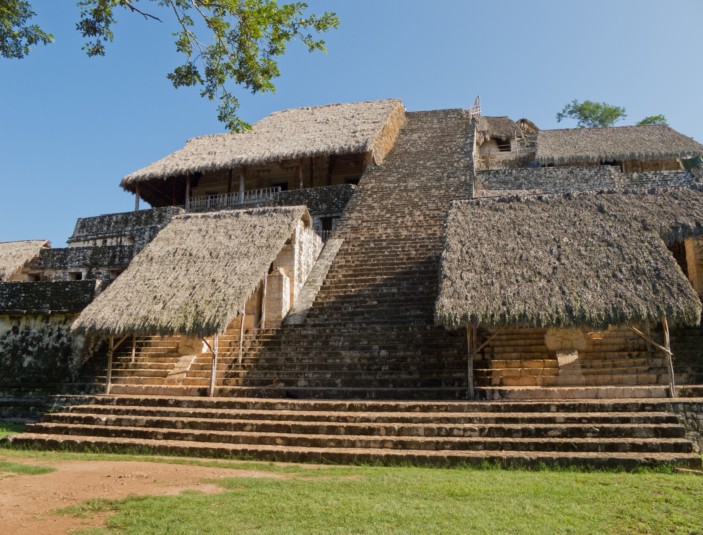 Ek Balam
Ek BalamEk Balam, is a spectacular archaeological site in the heart of Yucatán. It is not as famous as Chichén Itzá, so you can access without standing in long queues, take pictures without crowds and walk around quietly. However, the best part is that you are still allowed to ascend to the top of the pyramids to enjoy the view of the spectacular jungle that surrounds it.
Ek Balam (Jaguar Star or Black Jaguar according to some interpretations), was the Mayan capital of a territory known as Talol. Its territory was a bit over 10 square kilometers, and the elite of the population was concentrated in its center. This small area of approximately one square kilometer used to be protected by walls.
Ek Balam has about 40 structures. Among the most important are a beautiful arch that welcomes all visitors, the ball game, the acropolis, the twin pyramids and a glyphic corpus representing an Ek Balam governor.
At the Acropolis you can also admire the great artistic work of the Mayans, with beautifully carved low-relief murals, inscriptions and a beautiful scenery where you will literally feel on top of the Mayan world.
After visiting the archaeological zone, you can visit the Xcanche cenote, which is about 1500 meters away. In fact, a few steps from the ticket office of the archaeological zone you can find a small place to rent bikes to commute to the cenote.
The Chichén Itzá Light Show, known as the Nights of Kukulkan, which with an amazing mix of light and sound has allowed us to visit this important archaeological site at night for several years.
Nights of Kukulkan shows us a spectacularly synchronized display of light and sound of the Mayan history. Animated images- projected on the impressive pyramid- tell us stories about gods and humans, rites, customs, the knowledge of the cosmos and mathematics, and so much more.
Throughout the night tour of the archaeological zone of Chichén Itzá and with the show "The Nights of Kukulkan" we can discover the most relevant sites of this complex, namely: the Temple of the Jaguar, the Temple of the Big Tables and the Temple of the Warriors; the ball game, the platform of the skulls or Tzompantli, the Temple of Eagles and Jaguars, the Temple of Venus; the Kukulkán pyramid also known as "The Castle", and the Group of the Thousand Columns.
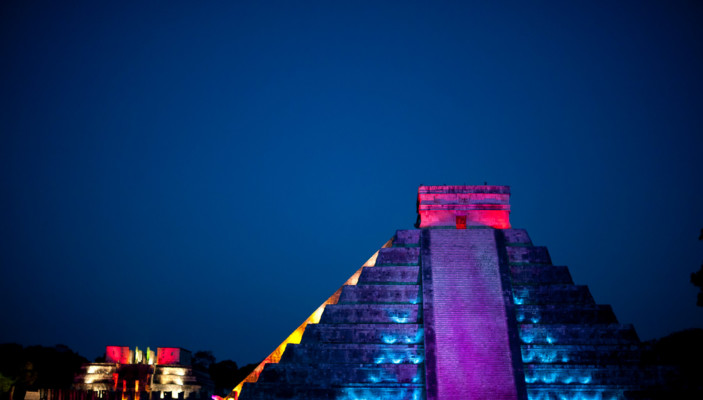 Nights of Kukulkan
Nights of KukulkanKukulkan's evening show schedule varies depending on the season, winter or summer. In either case, it is recommended to be there 15 minutes ahead the opening time.
Ik Kil complements a beautiful ecosystem, housing a large number of birds and other species. Whether you arrive after visiting Chichén Itzá or the caves, you can rest or spend the night in the nearby cozy cabins.
It is one of the most visited cenotes in the area, perhaps because of its alluring natural beauty. To enter the cenote, you must go down a wide stone staircase of approximately 26 meters, until you get to a platform from which you can just walk into the water. If you are bold enough, you can jump dive for a gutsy experience.
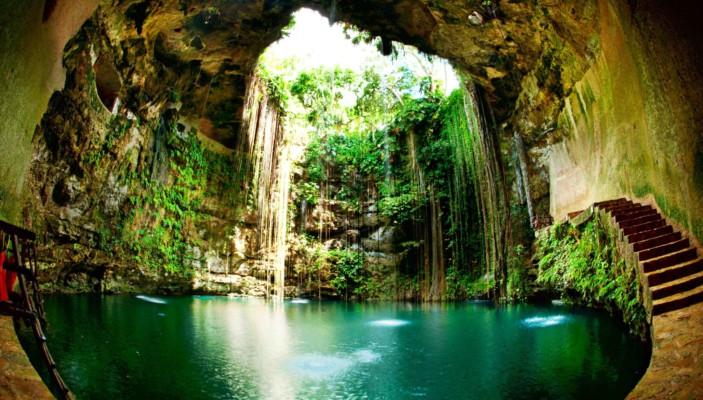 Cenote Ik Kil
Cenote Ik KilThe Yucatán is known for its haciendas. These were built in the second half of the 19th century with the support of the ancient families that had large territorial properties since colonial times, through the participation of their heirs and the sponsorship of new wealthy groups that had developed from the trading business.
Moreover, the state is known for being full of cenotes, fantastic watersheds and caves that were flooded during the last glaciation. Besides being time capsules in which incredible limestone formations can be observed, they constitute the main source of fresh water in the region, since there are no rivers on the surface due to the layer of limestone found below the state.
Currently there are approximately 3,000 cenotes registered in the state of Yucatán whereof less than half are open to the public and approximately 300 "haciendas" distributed in the municipalities of Cuzamá, Chocholá, Hocabá, Homún, Izamal, Motul, Sotuta, Tecoh, Tixkokob, Uman, among others.
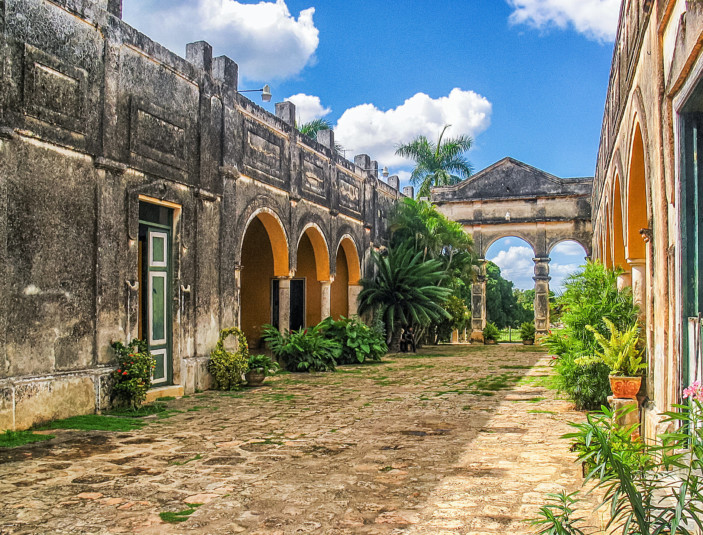 Hacienda Yaxcopoil
Hacienda YaxcopoilYaxcopoil is an estate where time just seems to stand still. You will pay an entrance fee of $100 pesos per person to wander freely through the bedrooms in the main house. There you will see the large dining rooms and captivating bedrooms with high ceilings, original mosaic floors, and European furniture in each bedroom.
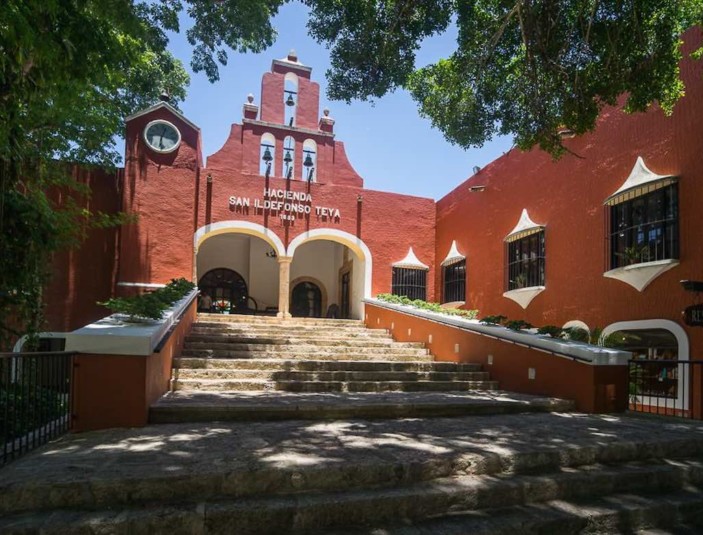 Hacienda Teya
Hacienda TeyaTeya is only 12.5 kilometers from Mérida and has gradually become a major attraction for visitors. Its architecture enchants all those who visit it, because of its green areas and corridors, the countryside atmosphere and the essence of the past that can be beheld in its facilities. To be at Hacienda Teya is like going back in time.
The hacienda has been noticeably refurbished. Today, it is recognized for its restaurant of exquisite Yucatecan food, for its green areas and halls for social events within a structure of 17th century buildings and exuberant vegetation. In addition, at the hacienda you will find a shop, a chapel, suites, and a breathtaking ballroom with mirrors and shiny pool that will really impress you.
Teya has received international celebrities such as Queen Sofía from Spain, Hillary Clinton, the Dukes of Luxembourg, among others.
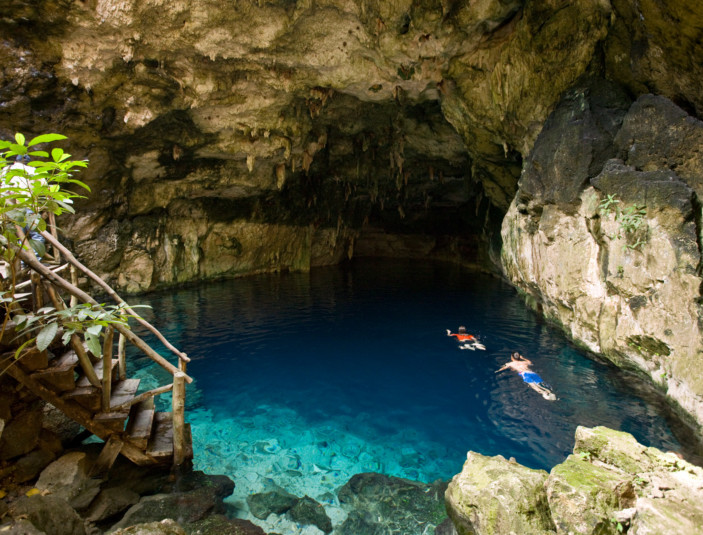 Cenotes de Cuzamá
Cenotes de CuzamáThe cenotes in the municipality of Cuzamá, considered some of the most beautiful, are perfect for practicing extreme sports.
You can get there by taking a "truck": transport pulled by mules or horses on rails, which were used to transport henequen leaves from the plantations to the machinery rooms of the haciendas.
Motul is located 40 km from the city of Mérida. It is mainly distinguished by its cuisine, specifically by the "huevos motuleños" (fried eggs over black beans on a fried tortilla, served with salsa, plantains, chorizo, and queso fresco). It is an easy destination to visit since its attractions are nearby, so you can visit all of them in one day.
It is highly recommended to try the huevos motuleños. You can try them at the local market, where there are several stalls to enjoy this gastronomic delight. They usual order is served with two eggs, but you can have them any way you prefer.
You can also enjoy the Sambulá cenote which is located south of Motul. The atmosphere is quiet and the cenote is very clean. It has green areas, palapas, dining areas and everything you need to spend a pleasant time with your family or friends.
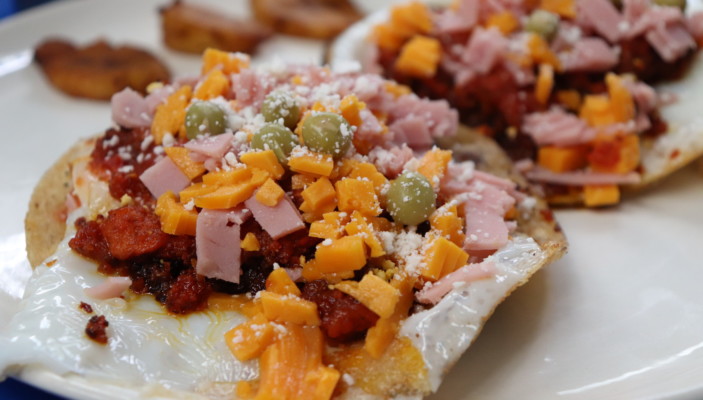 Huevos motuleños
Huevos motuleñosIzamal is a beautiful colonial city founded in the mid-sixteenth century on the remains of an ancient Mayan city. This place is known as "City of Hills", retracing the covered pyramids that used to be there when the Spanish arrived. There is also "The City of Three Cultures" named like this because of its blended features of its pre-Hispanic past, the colonial period and the present time.
Nowadays, most of its historical buildings and houses are painted in yellow and white by agreement of local authorities and neighbors, thus preserving a depiction of elegance and charm of a bygone era that singularizes and defines it with a manor glam in the regional context.
In its neatly stamped streets, horse-drawn barouches take the visitor on a charming ride through its squares, parks and its historic suburbs.
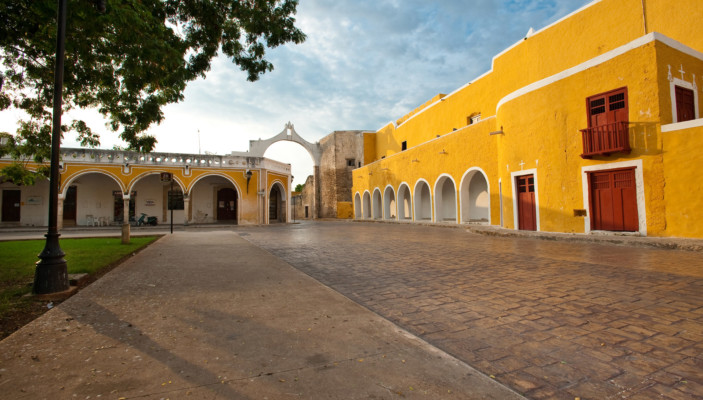 Izamal
IzamalAt night, the city offers a singular experience, when contemplating a starry celestial vault outlined by the profiles of its pyramids, temples and colonial houses; shades that seem to taken up from a centuries-old dream.
This is one of the most important and majestic buildings in Mesoamerica. It is located on the plateau of the main hill of the city. You can walk up to it by means of three ramps built on its sides.
Inside the temple there is a beautiful baroque style altarpiece, covered with gold. It shows scenes representing "The Death of Jesus", "The Birth", "The visit of the Virgin to Saint Elizabeth" and "The visitation of the angel to Mary". At the bottom, there are niches that let you see the images of "Santa Lucía", "San Antonio", "San Francisco" and "San José". In the upper part, there is a representation of "the Coronation of the Virgin as Queen of Heaven" and below, the image of the Virgin of the Immaculate Conception, a sculpture that was brought by Fray Diego de Landa from Guatemala, which also has a simple rail system that conveys with the Camarín, a space where the religionists show their faith and devotion.
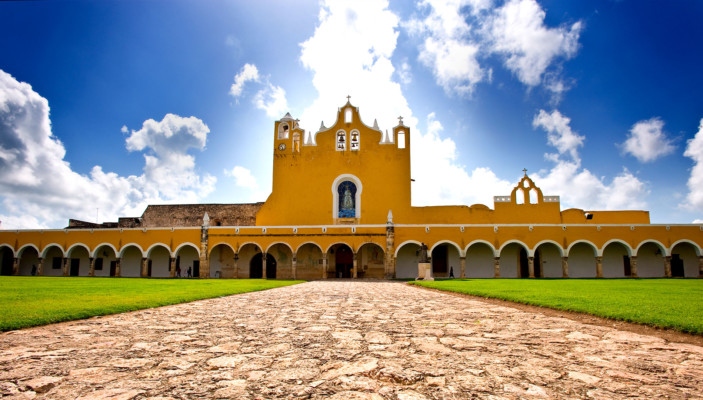 Convent of St. Anthony of Padua
Convent of St. Anthony of PaduaIt means "Fire Macaw with a Solar Face". It is interpreted that the Mayans believed that the god Kinich came down in the heat of the noonday sun, to burn and therefore purify the sacrifices or offerings brought to the Mayan pantheon, using the form of a macaw. It is the largest in surface of the Yucatán Peninsula and the third of Mexico after the Pyramid of the Sun in Teotihuacán and Cholula in Puebla.
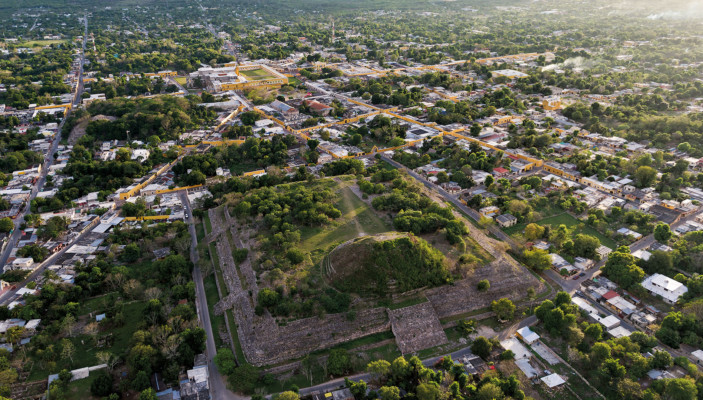 Kinich Kakmo Pyramid
Kinich Kakmo PyramidThe capital of Yucatán is the best place to start your tour and to explore the state. Founded in 1542 and built on the ancient Mayan city of T'ho, it stands out for its wide offer of cultural and artistic attractions, its colonial historic downtown with European architectural influence and an outstanding French style that we can admire in the large houses of Paseo de Montejo, the most important avenue of the city. It was recently awarded as "Best small city in the world" and "Best convention venue" by specialized tourism media.
The city is the most important distribution center for cultural tourism in the Yucatán Peninsula: offering more than 5,919 rooms in hotels for all budgets, congress and exhibition venues, more than 300 restaurants of all kinds of cuisine and, a wide range of cultural and tourist attractions.
It offers you varied options of culture, history, entertainment and its delectable gastronomy. Therefore, we suggest you start your visit in the historic downtown of the city, where you can stroll around and admire a great variety of colonial buildings, museums, galleries, theaters, outdoor cafés, bars, typical clothes, parks, hotels, restaurants with national and international cuisine.
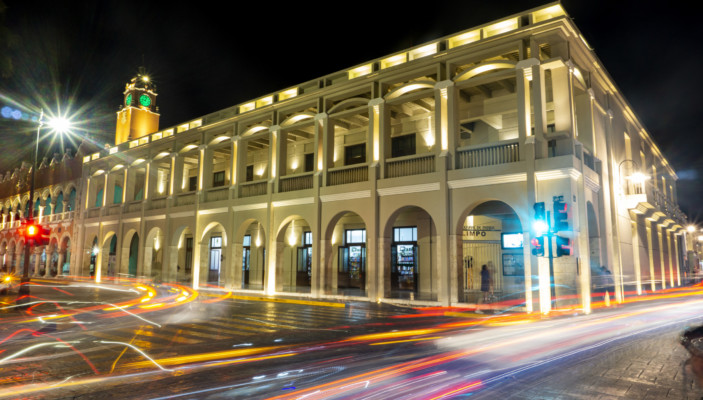 Centro Cultural Olimpo
Centro Cultural OlimpoAll this ancestral tradition coexists day after day with a modern, diverse and avant-garde city, where connectivity, mobility, services, efficiency, multiculturalism and good practices set us as a reference of quality of life in the world.
We have modern buildings, two convention venues, museums, an international airport, restaurants, golf courses, hotels, a vibrant nightlife and a first-class infrastructure.
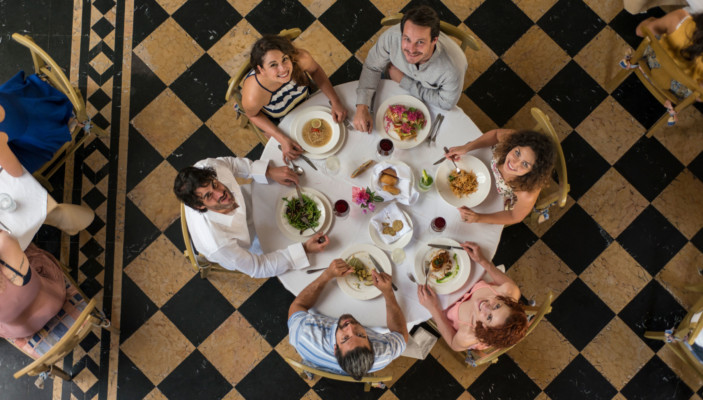 Hacienda Xcanatún
Hacienda XcanatúnThe local gastronomy stands out for its taste and tradition. With a selection of more than 280 restaurants, Mérida is able to satisfy even the most demanding tastes. We can find all sorts of restaurants or markets, from traditional to high cuisine, where they use ancient Mayan techniques, endemic ingredients and a unique technique for baking and cooking with a system of burial of clay pots with dry wood that provides unique aromas and flavors.
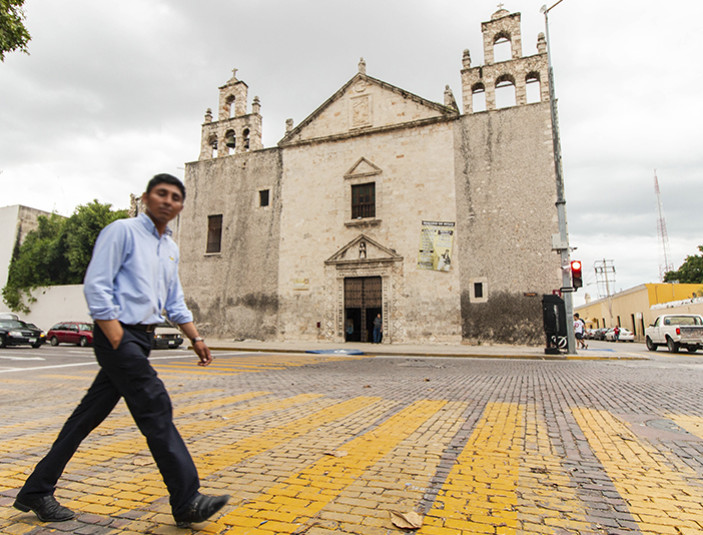 Barrio de La Mejorada
Barrio de La MejoradaLa Mejorada "barrio" (neighborhood), has a seventeenth-century church, which served throughout its history as a hospital, women's prison and barracks. This church is currently the Faculty of Architecture of the Autonomous University of Yucatán. Here you can also find the park of La Mejorada that is an essential part of the city of Mérida, where the first railroad in the Peninsula was built in 1870.
In this old neighborhood we can visit the Museum of Popular Art in the Casa Molina, the Museum of the Yucatecan Song, the historical "Arco de Dragones", "Arco del Puente", Yucatán Children's Cultural Center and, the Museum of the Railroad.
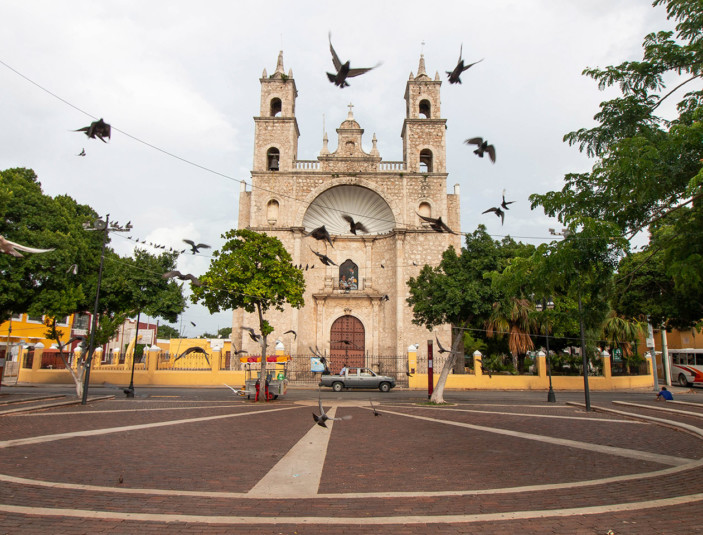 Barrio de San Cristóbal
Barrio de San CristóbalIn the beautiful neighborhood of San Cristóbal, the City Museum is a cultural element of great importance to the city of Mérida, both for its architectural features and for its historical value. There, you can find the former Federal Post Office, the Lucas de Galvez Market, the San Benito Market, the Craft Market, and the Garcia Rejón Bazaar.
The beauteous Church of San Cristóbal, with the advocacy to the Virgin of Guadalupe, is home of pilgrimages and processions every December 12th.
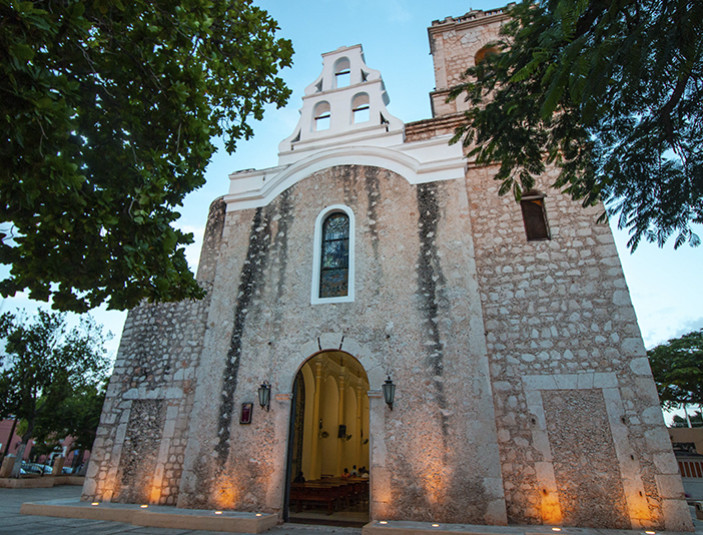 Barrio de San Sebastián
Barrio de San SebastiánIt is one of the oldest and most traditional "barrios" in Mérida. In ancient times, it used to be a little Mayan village settled southwest of Mérida, and changed its name by the time of the colonization to San Sebastián.
Some people think Montejo's troops passed through it when they came to T'ho. In this traditional neighborhood we find the Ermita de Santa Isabel which dates from the 17th century; it was formerly called the Ermita de Nuestra Señora del Buen Viaje, possibly because of its location near the royal path of Campeche.
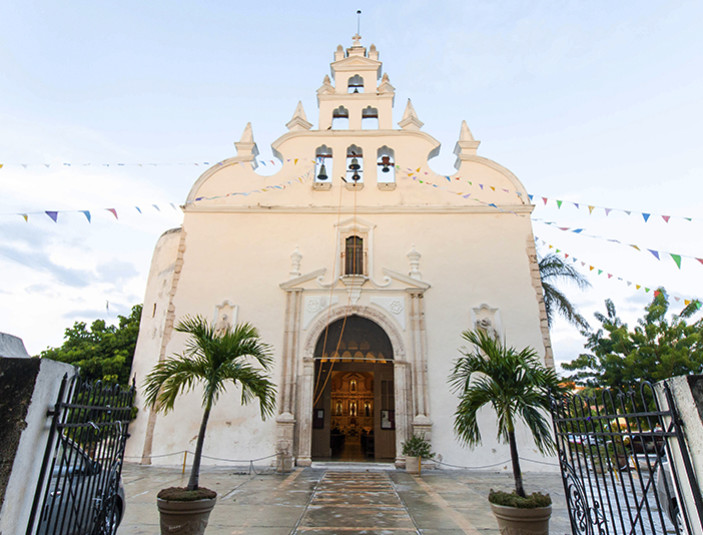 Barrio de Santiago
Barrio de SantiagoAs a result of the henequen bonanza that the region experienced towards the end of the 19th century, a group of Yucatecan potentates decided to start a project to build a public promenade "worthy of the city of Mérida" and to modernize the capital by the end of the 19th century.
The now known as Paseo de Montejo, built between 1886 and 1905, was inspired by the Champs-Elysées in Paris and named after the founder of the city of Mérida, Francisco de Montejo y León, "El Mozo".
In this beautiful avenue you can find some of the most renowned historical monuments of the city such as the Twin Houses or Chamber Houses, the grandiose Canton Palace, the Minaret Pawn House, the Regil Pawn House, the Quinta Montes Molina, the monuments to Justo Sierra and Felipe Carrillo Puerto and, the famous Monument to the Fatherland that is one of the most important symbols of the city, made by the Colombian master Rómulo Rozo.
The oldest and most beautiful theater in Mérida is named after José Peón Contreras, an immortal novelist poet, playwright, essayist, doctor and politician from Yucatán, who was born in this city in 1843 and died in Mexico City in 1907.
Inspired by the French neoclassical style, this theater was inaugurated on December 21, 1908. The original project was commissioned to the architect Pio Piacentini, the technical direction was carried out by the architect Enrico Desserti, the sketch and painting of the dome is by Nicolás Allegretti and the façade of the building with a marked European style is the work of Fernando Ceicola. In December 2008 the theatre celebrated its 100th anniversary.
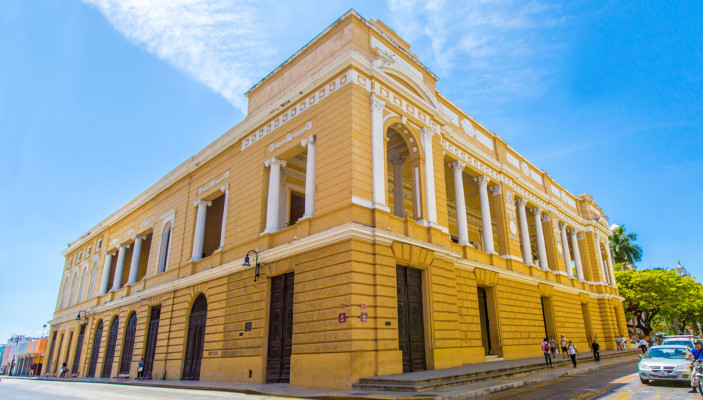 Peón Contreras Theater
Peón Contreras TheaterIts distribution and façade reminisce the great European theatres of the time. From the center of the dome hangs a chandelier which arms have prisms made of iridescent cut glass. The scenic arch presents lateral columns of Corinthian order, with the adjustments required by the construction systems and materials of the region considering that many of them were imported. It is opulently decorated, majestic and majorly spacious inside.
The Great Museum of the Mayan World is a modern and avant-garde cultural space considered one of the most important in Latin America. It has four permanent exhibition halls of the Great Museum of the Mayan World have a high thematic content to display the archaeology, anthropology, ethnology, history and customs of the Mayan world in the region.
The architectural conceptualization of the building is based on one of the key elements to understand the mysticism of the Mayan people: the ceiba tree. The main building resembles the ceiba tree which represents the sacred tree of life for the Mayans. Based on this concept, an architectural design is developed including a parking lot, transit warehouses, main reception room, permanent exhibition rooms, temporary exhibition room, multi-purpose room, children's playground, film projection room with a Mayamax screen, terraces and gardens.
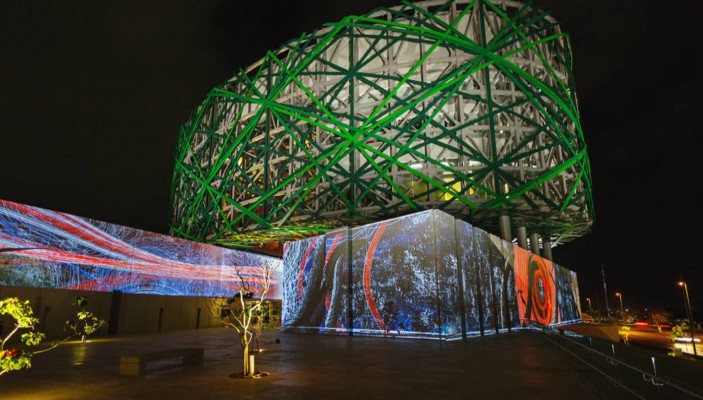 Great Museum of the Mayan World
Great Museum of the Mayan WorldThe museum exhibits a magnificent collection of more than 1,160 pieces for you to enjoy representative pieces such as textiles, religious objects and diverse objects that reflect the current daily life of the Mayans; engravings, books and historical documents, artistic and religious works from the viceroyalty period; pre-Hispanic era collections that include stelae, bas-reliefs and stone sculptures; pottery vessels, trousseaus and ceramic offerings, in addition to decorations and sumptuary objects made of gold, jade and shell.
The Casa de Montejo, built between 1542 and 1549 commanded by Don Francisco de Montejo, conqueror of the Yucatán Peninsula, is one of the scant examples on the American continent of civil constructions in the Renaissance style known as Plateresque. It preserves the 16th century facade, being a representative masterpiece of that artistic style. It is one of the five Casas Señoriales Banamex, offered to the public by the Banco Nacional de México. These houses are historical-cultural spaces which purpose is to contribute to the cultural, social, ecological and educational development of our country.
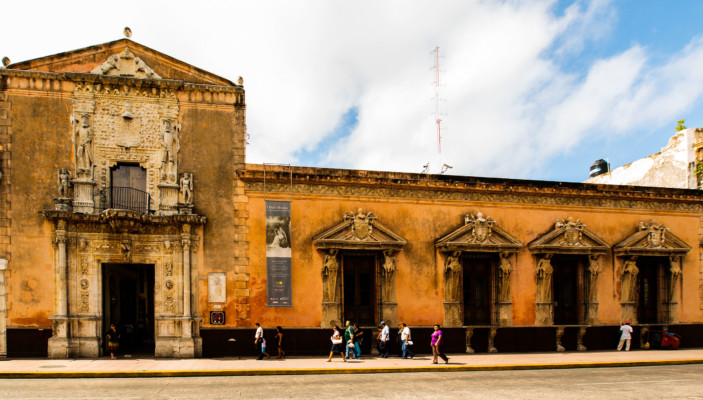 Museo Casa Montejo
Museo Casa MontejoThe Museo Casa Montejo has four permanent rooms as a site museum: the studio/library, the living room, the bedroom and the dining room, all set in the style of the last quarter of the 19th century and the first quarter of the 20th century in Mexico. It also has three temporary exhibition halls where temporary exhibitions will be presented to allow artistic appreciation, as well as a program of conferences, concerts and the work of the Great Masters of Popular Art.
Considered one of the oldest Mayan cities, it stands for "the place where there is writing on flat stones". Dzibilchaltún amalgamates in one place a pre-Hispanic city, an eco-archaeological park and the Museum of the Mayan People, which houses Mayan and Spanish remains, from clay objects to paintings, Spanish armor and weapons, several Mayan stelae, stones and carved lintels in excellent condition.
Dzibilchaltún also has a 16th century Franciscan chapel, which is located right in the center of the Mayan city.
Dzibilchaltún is located on kilometer 14 of the Mérida-Progreso highway. It can be visited every day from 8:00 to 17:00 hrs.
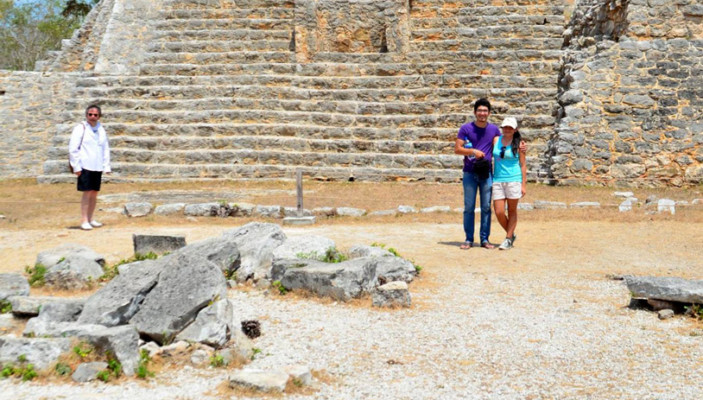 Dzibilchaltún
DzibilchaltúnThe city preserves 12 sacbés (sak bé oob) or white roads, most of which start from the center and go toward the constructions on the outskirts. One of them leads to the Xlacah cenote, which in Mayan means "old town", one of the largest and deepest found in Yucatán thus far, and from which a great number of archaeological pieces have been rescued, mainly pottery.
Xlacah is a kind of natural outdoor pond and is easily accessible, since it is at ground level. Its crystalline waters, covered with lilies floating on the surface, enhance their beauty as the sunlight goes through them, thus being eternal witnesses of the greatness of this place.
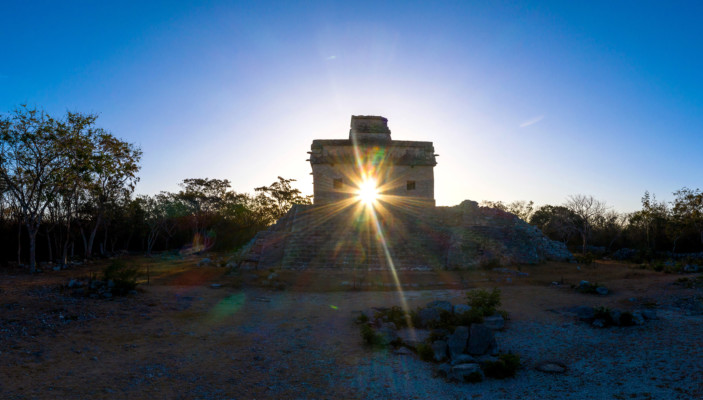 Dzibilchaltún
DzibilchaltúnThe archaeo-astronomical phenomenon of the equinox occurs in Dzibilchaltún, on March 21st and on September 21st. At dawn, when the door of the Temple of the Seven Dolls is illuminated by the sun glare that comes from the horizon, at a certain moment, the celestial sphere is in the center of the door and creates an amazing display of light and shadow on the western façade. These days, you can observe the incredible precision of Mayan astronomy integrated into its architecture. The Mayans used the sun as the basis for planning their lives because they lived from the agriculture. During the spring equinox they started the sowing and in the autumn equinox they did the harvest.
The Museum of the Mayan People is made up of 4 exhibition halls:
The Pergola of the Monoliths: where pre-Hispanic monolithic sculptures from Yucatán, Campeche and Quintana Roo are exhibited at the edge of a path that runs through a garden of native plants.
The Room of Mayan Archaeology: dedicated to the pre-Hispanic era, it exhibits a collection of ceramic, and architectural elements from Chiapas, Campeche and the Yucatán itself, arranged in such a way as to illustrate themes such as the Mayan concept of the universe, the emergence of man, the relationship between man and nature, the gods, social stratification, painting, writing, specialization of work and the tracking of time.
The History Room: where a special space is dedicated to the Archaeology of Dzibilchaltún, the Contact and Conquest of the Mayan People and the formation of the Yucatecan identity.
The Solar Maya: an annexed area where a typical Mayan rural house was built, made using traditional techniques, materials and labor.
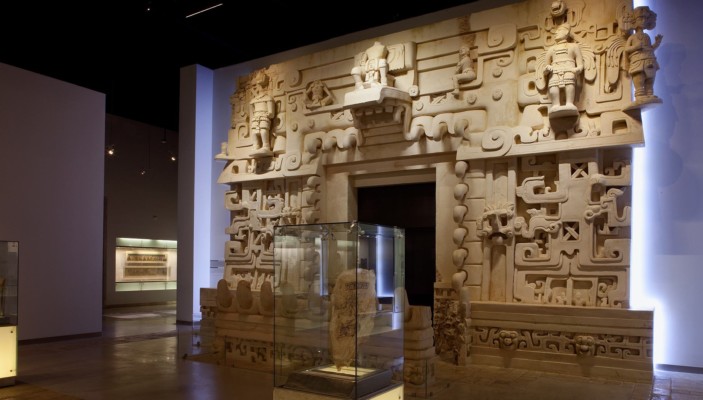 The Museum of the Mayan People
The Museum of the Mayan PeopleThe Puuc Route (puuc means "mounds") is a tour of archaeological sites that has undoubtedly become one of the favorite walks for Yucatecans and visitors to the region.
This tour includes the archeological sites of Uxmal, Kabah, Sayil, Xlapak, Labná, Oxkintok, Calcehtok Caves and the Loltún Caves. Throughout the tour you will find structures that have been completely restored, others that are still in process and some that are covered with grass, trees and dense vegetation. The latter are very similar to those found by the first explorers at the end of the last century.
In addition, when making the journey through this route, you will find towns full of history, craftsmen and the best of Yucatán cuisine.
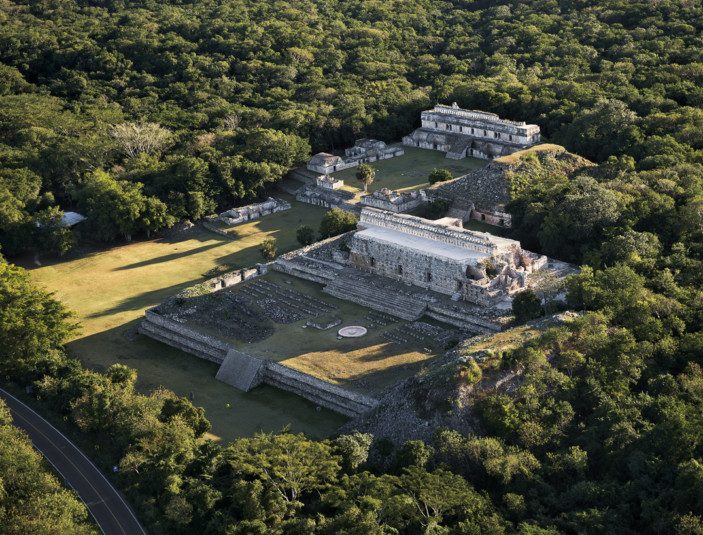 Kabah
KabahKabah, which has name has been interpreted as "Lord of the strong or powerful hand”, is located 23 km southeast of Uxmal on highway 261, taking the detour to the right on km 16, near the city of Ticul. The importance of this city can be understood based on the fact that the Mayans mention it in the Chilam Balam, even after the Spanish conquest. Consequently, it is believed that it was as important as the one of Uxmal.
The ruins are spread on both sides of the road in a very extensive area of the jungle. They are located on the lower part of a valley, surrounded by mid-hight hills with small temples which can be seen at their summit; from the top of this hills the buildings of Nohpat and Uxmal can be clearly admired.
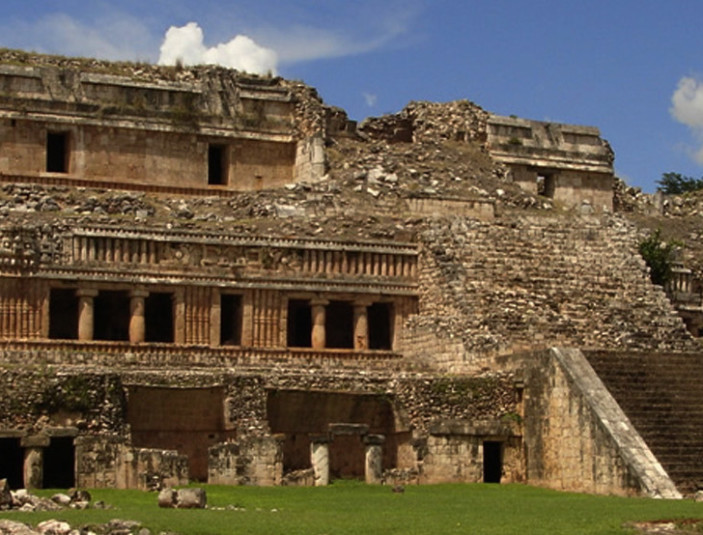 Sayil
SayilOne of the most important settlements in the Puuc area is Sayil, considering that there were approximately 17 thousand inhabitants in this place, which explains its size and distribution. It is located 33 km southeast of Uxmal on highway 261; turn right at km 34.
In contrast to most known names for pre-Hispanic sites, this one is truly ancient. Built in a long valley, surrounded by low, somewhat rugged hills. The location is rather inhospitable, due to the lack of water on the surface. For this reason, the Maya built a large number of underground deposits or cisterns, known as “chultunes”, in order to recollect and store rainwater.
Literally, it means "Place of the Arriero ants". In the Mayan language, the word “say” is used to make reference to this species of insects that usually cut and carry pieces of leaves.
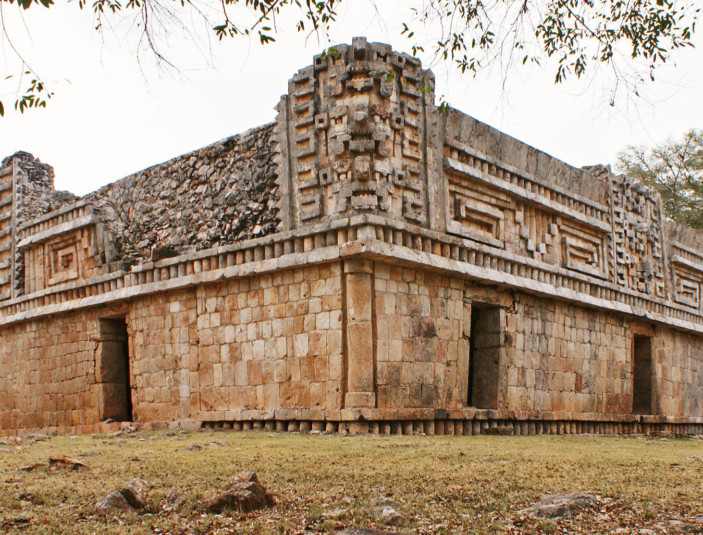 Xlapak
XlapakXlapak belongs to the Puuc region which had its golden age between 600 and 1000 A.D. Like most of the inhabitants of the Mayan area, the ones of Xlapac were dedicated to growing crops, building chultunes (cisterns) and watering holes to recollect rainwater. They were deeply religious and worshipped Chaac, the rain god, on whom they relied on for their livelihood.
It is a site where important Mayan buildings have been gradually discovered. The is one that stands out for being richly decorated with masks of the god Chaac (god of rain and/or water). Wandering around it and discovering its archeological jewels is a real delight for the visitor.
Xlapak is located 38 km southeast of Uxmal on highway 261 and connects to the state highway 31 on the left. This area has a craft store to buy souvenirs.
Uxmal -surrounded by legends, myths and anecdotes- is truly poetic, both in its name and history. It is located in the Santa Elena Valley next to a series of hills known as Puuc, which in Mayan language means "mountain range". Its name was then given to this architectural style to the buildings in the region.
It is estimated that it had a population of nearly 25 thousand inhabitants, distributed in a territory of 37.5 square kilometers. It had enormous agricultural potential, but lacked permanent sources of water, which explains why the Mayans constructed Chultunes, or water deposits, and a complex system of watering holes and bukteoobob, to recollect rainwater efficiently.
The occupation dates back to 500 B.C. However, during the nineth and twelfth centuries A.D. it was the center of peninsular Mayan political and economic power in the Puuc region.
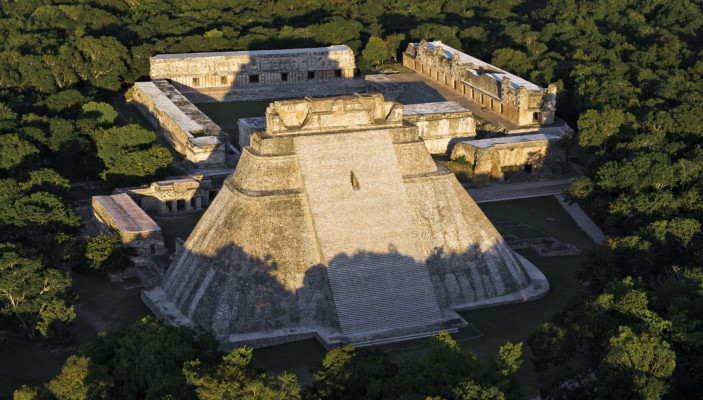 Uxmal
UxmalLoltún is located south the state, where evidence of human settlements dating from 400 to 700 years ago have been found. Its name in Mayan stands for "Stone Flower". It is the name of unique caves which have formations and some geometric shapes that catch the attention of both locals and foreigners.
Another interesting attraction are the cave paintings: on one wall you can see hands in negative, on another one you can find more elaborated paintings that represent faces, animals and staggered fretwork.
In the gallery there is an enormous vault known as the Cathedral. Along the tour you can see colorful displays of light and shadow, produced by the entrance of the sunlight through various cavities.
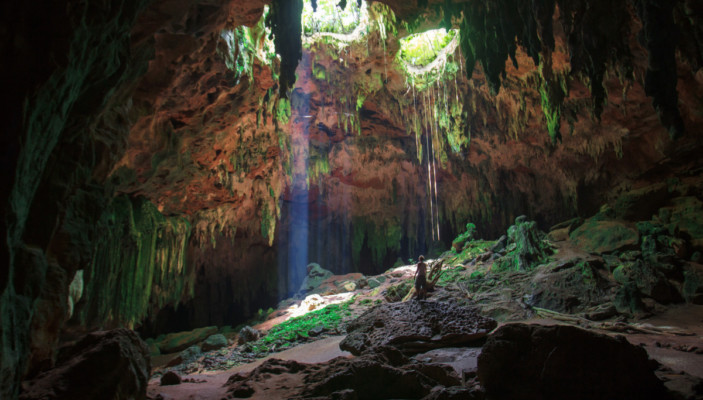 Grutas de Loltún
Grutas de LoltúnThe Mayans used it both to extract clay to make their utensils and, as a religious center and shelter.
